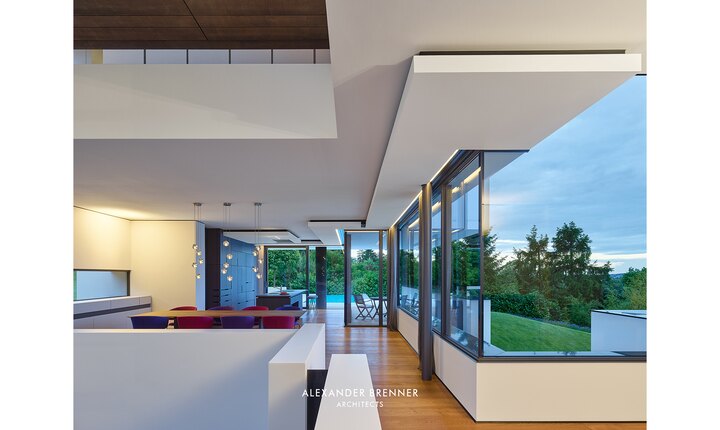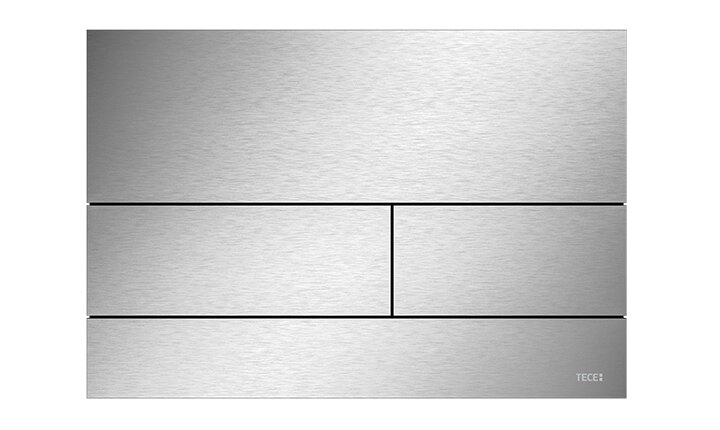
Harmony of contrasts
Clearly structured cubes meet gently curved lawn edges. Lightly plastered concrete contrasts with the green of the adjacent nature. The summer sky is reflected in the glass of the panorama windows, while inside the exposed concrete wall with a zebra pattern transports the residents to Africa. Architect Alexander Brenner has created a world of powerful contrasts in Sonnenberg House. And yet they form a unity into which solutions from TECE integrate harmoniously and functionally.

Weliving sculpture that inspires
The Sonnenberg House is less a building than a residential sculpture - and Alexander Brenner is more of a building artist than "just" an architect. The needs of his clients are just as important to him as the relationship of the architecture to the surroundings. His clients are enthusiastic about this holistic philosophy and are not only guided by the price per square metre.
Shelter with nature connection
Technical refinements and material science, statics, haptics, colour theory and design language: Brenner takes every detail into account in order to create "building art". But despite all the complexity, one thing above all counts for him: that his buildings fulfil their original function as ideally as possible. And what is that? "To offer people protection and security," says Alexander Brenner, "and to fulfil their desire for an intensive connection to nature.
Rooms full of light and air
This basic idea also guided Brenner in the design of the Sonnenberg Villa: the entrance is reached via a small forecourt. Inside, those arriving encounter vastness and light: a large air space with generous window areas and skylights connects all three floors with each other and allows for versatile views.

Photo: © Alexander Brenner Architects
From the garden floor, a sculptural staircase leads along the zebra pattern wall to the ground floor. Alexander Brenner designed it as an open space continuum with window fronts facing west and south, so that the architecture opens up to the landscape almost without boundaries. The private living areas with balconies and loggias are located on the upper floor.
Holistic down to the last detail
All areas, from the garden design to the lighting concept, are consistently worked through. "We design all our buildings down to the last detail," Brenner confirms. "We always design the entire interior as well." The tailor-made allows for sophisticated special solutions. However, clear surfaces, fitted fixtures and concealed technical elements also create a reduced backdrop. "A residential building must be like a canvas in front of which the lives of the residents can play," is how the planner sums up his approach.


What is sustainable is what remains permanent
Brenner's villas focus on short value chains and strengthening regional craftsmanship. His three-dimensional works of art made of concrete are built to last. "In many cases, houses are only designed for a life cycle of around 25 years," the architect says, annoyed by this disposable mentality. "They are regarded solely as commodities.
Aesthetics and functionality - with TECE in the bathroom
Timeless sustainability is also found inside the Sonnenberg House. This applies not least to the bathroom area with products from TECE. The TECE toilet module with concealed cistern is integrated into the masonry of the bathroom in a highly functional way. The modules make the installation of the washbasin and toilet so much easier that it can be done by just one fitter.
The TECEsquare metal actuator plate is an eye-catcher. The high-quality push-button mechanism of the strictly geometric toilet push plate can be felt with every touch. At the same time, users leave no marks on the surface, which is specially coated with "anti-fingerprint", because TECE relies on durable materials and aesthetic principles for its technical solutions. The result is durability - and built-in sustainability in bathroom design, so to speak.
Michael Schuster, Key Account Manager Architecture at TECE: "When architects and builders opt for a holistic architectural approach, buildings are created with design substance down to the last detail. We appreciate such an attitude and support it with technical solutions that meet the highest design standards."


Architecture that endures
The Sonnenberg House shows an art of building that wants to incorporate future developments. And in doing so, reinterprets familiar standards with playful ease. Exposed concrete? In vogue for years. But not in the form of an aerated concrete wall with a zebra look that extends over three storeys to the skylight. In addition, the large-pored surface quite practically ensures high sound absorption.
"We are committed to care, sustainability and durability," Alexander Brenner summarises. "Our way of working is holistic and aims for a total work of art in the architectural-historical sense."
